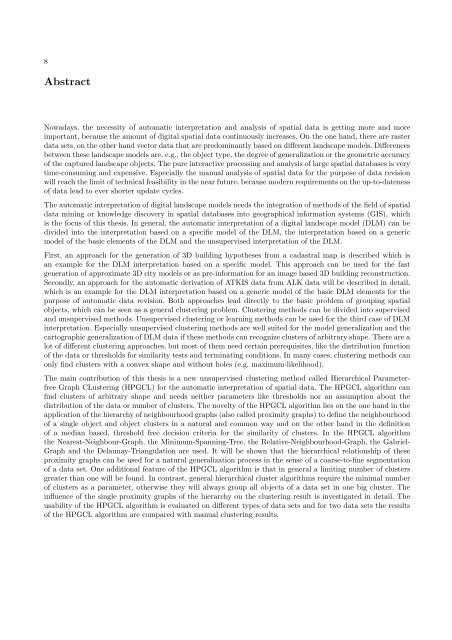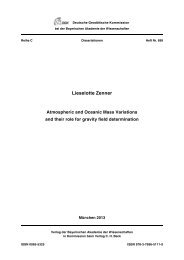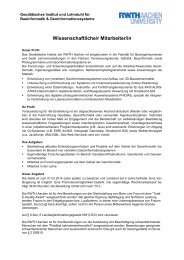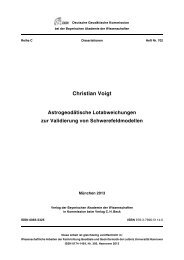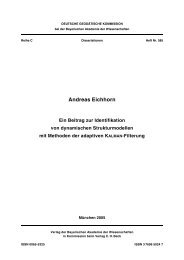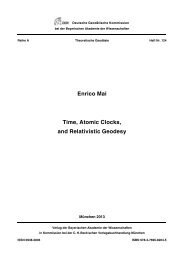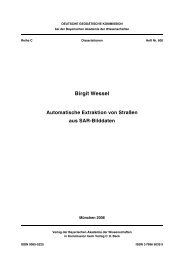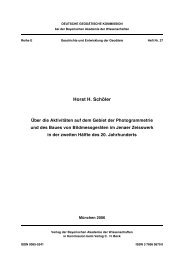PDF-Download - Deutsche Geodätische Kommission
PDF-Download - Deutsche Geodätische Kommission
PDF-Download - Deutsche Geodätische Kommission
Sie wollen auch ein ePaper? Erhöhen Sie die Reichweite Ihrer Titel.
YUMPU macht aus Druck-PDFs automatisch weboptimierte ePaper, die Google liebt.
8<br />
Abstract<br />
Nowadays, the necessity of automatic interpretation and analysis of spatial data is getting more and more<br />
important, because the amount of digital spatial data continuously increases. On the one hand, there are raster<br />
data sets, on the other hand vector data that are predominantly based on different landscape models. Differences<br />
between these landscape models are, e.g., the object type, the degree of generalization or the geometric accuracy<br />
of the captured landscape objects. The pure interactive processing and analysis of large spatial databases is very<br />
time-consuming and expensive. Especially the manual analysis of spatial data for the purpose of data revision<br />
will reach the limit of technical feasibility in the near future, because modern requirements on the up-to-dateness<br />
of data lead to ever shorter update cycles.<br />
The automatic interpretation of digital landscape models needs the integration of methods of the field of spatial<br />
data mining or knowledge discovery in spatial databases into geographical information systems (GIS), which<br />
is the focus of this thesis. In general, the automatic interpretation of a digital landscape model (DLM) can be<br />
divided into the interpretation based on a specific model of the DLM, the interpretation based on a generic<br />
model of the basic elements of the DLM and the unsupervised interpretation of the DLM.<br />
First, an approach for the generation of 3D building hypotheses from a cadastral map is described which is<br />
an example for the DLM interpretation based on a specific model. This approach can be used for the fast<br />
generation of approximate 3D city models or as pre-information for an image based 3D building reconstruction.<br />
Secondly, an approach for the automatic derivation of ATKIS data from ALK data will be described in detail,<br />
which is an example for the DLM interpretation based on a generic model of the basic DLM elements for the<br />
purpose of automatic data revision. Both approaches lead directly to the basic problem of grouping spatial<br />
objects, which can be seen as a general clustering problem. Clustering methods can be divided into supervised<br />
and unsupervised methods. Unsupervised clustering or learning methods can be used for the third case of DLM<br />
interpretation. Especially unsupervised clustering methods are well suited for the model generalization and the<br />
cartographic generalization of DLM data if these methods can recognize clusters of arbitrary shape. There are a<br />
lot of different clustering approaches, but most of them need certain prerequisites, like the distribution function<br />
of the data or thresholds for similarity tests and terminating conditions. In many cases, clustering methods can<br />
only find clusters with a convex shape and without holes (e.g. maximum-likelihood).<br />
The main contribution of this thesis is a new unsupervised clustering method called Hierarchical Parameterfree<br />
Graph CLustering (HPGCL) for the automatic interpretation of spatial data. The HPGCL algorithm can<br />
find clusters of arbitrary shape and needs neither parameters like thresholds nor an assumption about the<br />
distribution of the data or number of clusters. The novelty of the HPGCL algorithm lies on the one hand in the<br />
application of the hierarchy of neighbourhood graphs (also called proximity graphs) to define the neighbourhood<br />
of a single object and object clusters in a natural and common way and on the other hand in the definition<br />
of a median based, threshold free decision criteria for the similarity of clusters. In the HPGCL algorithm<br />
the Nearest-Neighbour-Graph, the Minimum-Spanning-Tree, the Relative-Neighbourhood-Graph, the Gabriel-<br />
Graph and the Delaunay-Triangulation are used. It will be shown that the hierarchical relationship of these<br />
proximity graphs can be used for a natural generalization process in the sense of a coarse-to-fine segmentation<br />
of a data set. One additional feature of the HPGCL algorithm is that in general a limiting number of clusters<br />
greater than one will be found. In contrast, general hierarchical cluster algorithms require the minimal number<br />
of clusters as a parameter, otherwise they will always group all objects of a data set in one big cluster. The<br />
influence of the single proximity graphs of the hierarchy on the clustering result is investigated in detail. The<br />
usability of the HPGCL algorithm is evaluated on different types of data sets and for two data sets the results<br />
of the HPGCL algorithm are compared with manual clustering results.


